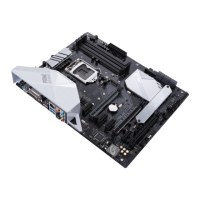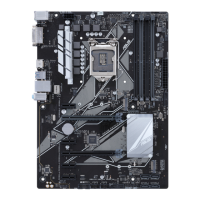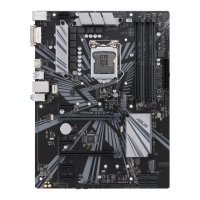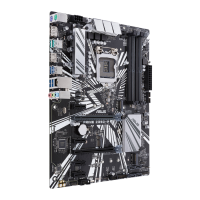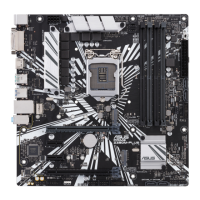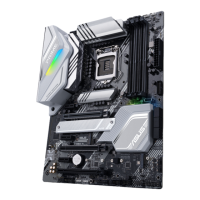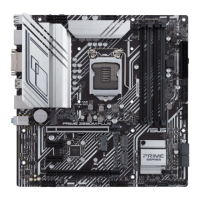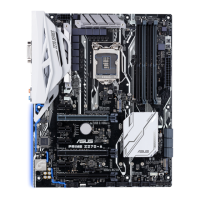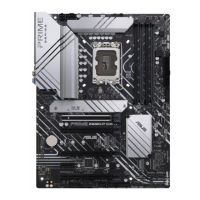
Do you have a question about the Asus PRIME Z370-A Series and is the answer not in the manual?
| Chipset | Intel Z370 |
|---|---|
| CPU Support | 8th Generation Intel Core Processors |
| CPU Socket | LGA 1151 |
| Memory Support | 4 x DIMM, Max. 64GB, DDR4 |
| Memory Speed | DDR4 4000(O.C.)/3866(O.C.)/3733(O.C.)/3600(O.C.)/3466(O.C.)/3400(O.C.)/3333(O.C.)/3300(O.C.)/3200(O.C.)/3000(O.C.)/2800(O.C.)/2666/2400/2133 MHz |
| PCI Express x1 Slots | 4 x PCIe 3.0/2.0 x1 |
| Audio | Realtek ALC887 8-Channel High Definition Audio CODEC |
| Form Factor | ATX |
| PCI Express x16 Slots | 2 x PCIe 3.0/2.0 x16 (x16 or dual x8) |
| Multi-GPU Support | NVIDIA 2-Way SLI Technology, AMD 3-Way CrossFireX Technology |
| Storage | 6 x SATA 6Gb/s |
| M.2 Slots | 2 x M.2 Socket 3 |
| USB 3.1 Gen 2 Ports | 1 x Type-A, 1 x Type-C |
| USB 3.1 Gen 1 Ports | 6 (4 at back panel, 2 at mid-board) |
| USB 2.0 Ports | 2 x USB 2.0 at back panel, 4 x USB 2.0 at mid-board |
| LAN | Intel I219V, 1 x Gigabit LAN Controller |
| RAID Support | RAID 0, 1, 5, 10 |
| USB Ports | 8 x USB 3.1 Gen 1 ports (6 at back panel, 2 at mid-board), 6 x USB 2.0 ports (2 at back panel, 4 at mid-board) |
General overview of the motherboard's components and layout.
Safety precautions and steps before installing system components.
Detailed diagram and labeling of the motherboard's connectors and features.
Information regarding the CPU socket, compatibility, and installation.
Details on DDR4 DIMM slots and how to install memory modules.
Description of the motherboard's PCIe slots and their operating modes.
Explanation of the motherboard's integrated buttons and switches for system control.
Information on the motherboard's jumpers for configuration and reset functions.
Details on the motherboard's diagnostic LEDs for system status indication.
Guide to various internal connectors on the motherboard for system components.
Step-by-step guide for assembling the PC system components.
Instructions for connecting rear I/O ports and audio devices to the motherboard.
Procedures for the initial power-on and system startup.
Basic instructions on how to properly shut down the computer system.
Introduction to the ASUS UEFI BIOS interface and its purpose.
Guide on how to enter and navigate the BIOS setup utility.
Overview of BIOS menus including My Favorites, Main, and Ai Tweaker for system configuration and tuning.
Detailed settings for CPU, platform, storage, devices, network, and power management.
Information on system temperatures, voltages, fan speeds, and monitoring tools.
Settings for configuring the system's boot order and startup behavior.
Access to BIOS update, secure erase, user profiles, SPD, and graphics info utilities.
Options for saving changes, loading defaults, and exiting the BIOS setup.
Procedures for updating the motherboard's BIOS for improved stability and performance.
Overview of Intel Rapid Storage Technology for RAID 0, 1, 5, and 10.
Explanations of different RAID levels and their advantages.
Guidelines to prevent electrical hazards when working with the motherboard and system.
Precautions for safe handling and operation of the motherboard and its components.
Explanation of the manual's structure and chapter breakdown.
Resources and links for additional product and software updates.
Explanation of text formatting, symbols, and key notation used throughout the manual.
Details on CPU, Chipset, Memory, Expansion Slots, VGA, Multi-GPU, and USB.
Specifications for Storage, LAN, and Audio interfaces.
Overview of ASUS Exclusive Features, Special Features, and Thermal Solutions.
Information on Back Panel I/O Ports and Internal I/O Connectors.
Details on BIOS, Manageability, OS Support, and Form Factor.
List of the motherboard, serial ATA cables, and SLI HB bridge.
Details on Q-Shield, Q-Connector, M.2 screws, fan holder, and user guide.
Illustrations of necessary tools like PC chassis, CPU, heatsink, PSU, and screwdriver.
Visuals of optional components such as SATA drives, optical drives, and graphics cards.
